What is the next comet to be visible from Earth?
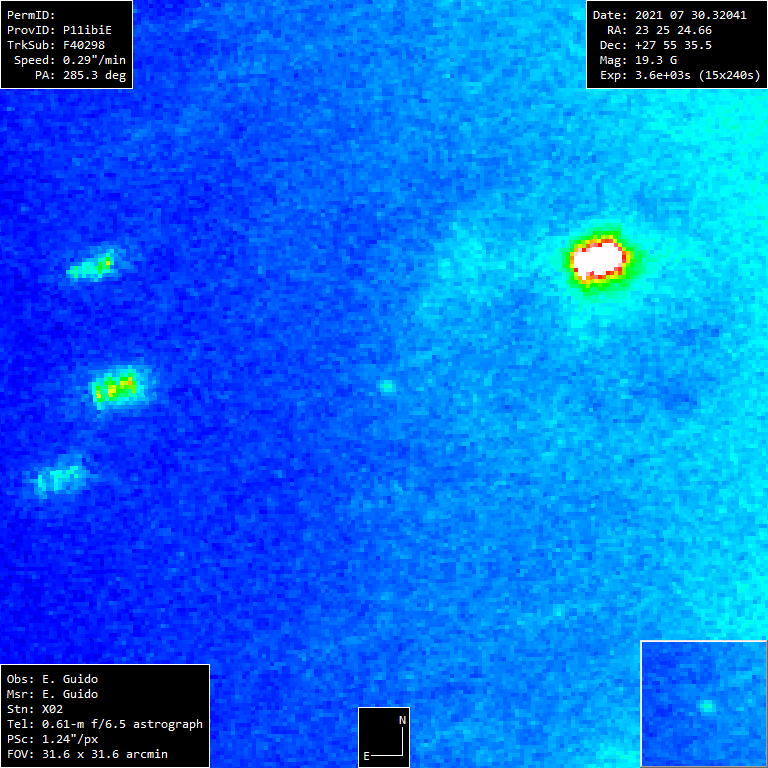
Comet C/2021 O3 due to sweep well-nigh sun
A comet discovered last July is fast approaching our part of the solar organization and might accomplish binocular visibility (at to the lowest degree) by May 2022. It's designated C/2021 O3 (PanSTARRS). Presently this comet is backside the sun, as seen from Earth. But it'll exist emerging into our western evening heaven at least by early May. Between now and then, the comet volition pass extremely virtually the sun. And it might not survive that passage. But if it does, get ready! Charts below.
Comet PanSTARRS will come shut to the lord's day, closer than the planet Mercury. Its closest point, chosen its perihelion, volition come on April 21, 2022. It'll sweep 0.29 astronomical units (AU) from our star (ane AU = 1 average Earth-sunday unit of altitude). So – given that Mercury's sunny side reaches temperatures of around 750 to 800 degrees Fahrenheit (upward to nearly 430 degrees Celsius) – you can run across that Comet C/2021 O3 (PanSTARRS) will really feel the sun'south heat.
That'south why Comet C/2021 O3 might disintegrate, equally some comets do, when nearest our star.
But, if it survives, many on Globe volition glimpse this traveler. The comet will exist at its closest point to Earth at 18 UTC on May 8. It'll sweep about 0.lx AU from us, or 50.9 meg miles (82 million km). That's virtually 200 times the moon's distance! Still, those with binoculars might be able to see this comet.
Company from the Oort Deject
Comet C/2021 O3 (PanSTARRS) appears to be "new" to the inner solar organisation, a starting time-time visitor. In fact, information technology's taken perchance millions of years to go far hither from the outer part of the Oort cloud.
The comet might have just enough escape velocity, after information technology sweeps almost our sunday this Apr, to suspension the bonds of our sun's gravity. If and so, after it sweeps past our sun, it'll veer into the wider space of our Milky way galaxy … never to return.
Merely will nosotros come across it?
Comets are icy bodies, and they are unpredictable. And this comet is coming closer to the sun than Mercury. The textile in its nucleus, or core, might simply eddy away. When this happens, the comet disintegrates. Another scenario is that the comet's nucleus might begin to spin and then rapidly that it fractures. When this happens, the smaller pieces melt chop-chop under the dominicus's rut.
In either case, the comet disappears.
If the comet doesn't disintegrate when it rounds the sun later this month, a few other possibilities exist. The comet could interruption into several pieces. Information technology could have an outburst in brightness for a few weeks as fresh material is exposed to sunlight. Comet West (1975 V1) did that in 1976, and it's sometimes described as a "great comet."
On the other hand, the nucleus, or core, of C/2021 O3 (PanSTARRS) could survive its passage nearest the sun, just to exist weakened and atomize a few weeks after perihelion. That happened earlier this year to Comet Leonard (C/2021 A1).
Or, as many comets have washed before it, this comet could pass through perihelion and enter our evening heaven unfazed.
So, no one knows exactly how bright Comet C/2021 O3 volition get. As a late American comet expert once said:
If you lot are going to bet, bet on a horse, non a comet.
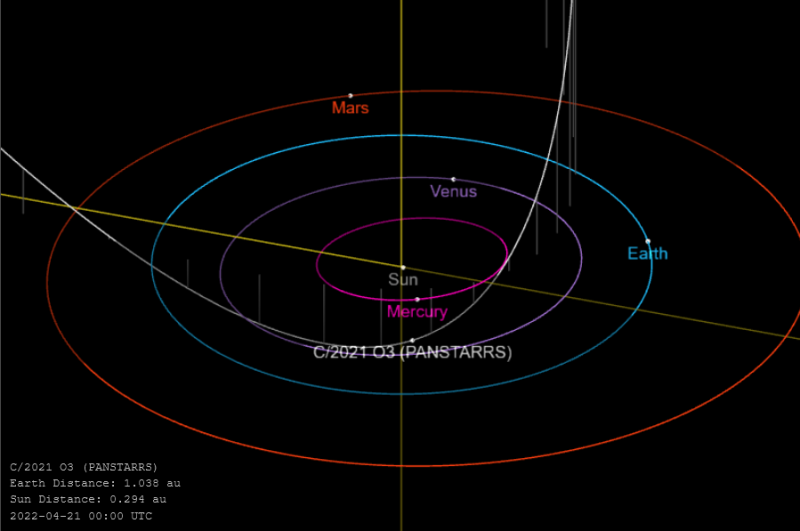
A brief history of Comet C/2021 O3
Scientists start observed C/2021 O3 (PanSTARRS) on July 26, 2021. They were using the 71-inch (ane.8-meter) Pan-STARRS 1 telescope located on the island of Maui in Hawaii. This telescope uses a one.iv gigapixel camera to paradigm the heaven in search of asteroids and comets. It has found more 250 comets since 2010. The Central Agency for Astronomical Telegrams announced the new comet via Electronic Telegram No. 5009.
Why did astronomers get excited about this comet? They found Comet C/2021 O3 (PanSTARRS) when it was however 4.3 astronomical units (AU) from the lord's day. And then it was more than 4 times World'south distance from the sun, simply closer to the sun than planet Jupiter. The comet appeared as a marginally fuzzy starlike object. Information technology was placed on the Possible Comet Confirmation Page, which prompted several teams of astronomers to examine it more closely under high magnification.
Then Ernest Guido of Italia imaged the comet and plant it had a small coma (atmosphere). The image at the top of this folio is his image; yous'll also notice it hither. Commonly, a comet's coma doesn't appear until a comet sweeps closer to the sun.
In this case, the presence of a coma for a faraway object suggested to astronomers a comet that's big and might become bright.
On August 2, 2021, the IAU Small Planet Eye in Cambridge, Massachusetts designated the object equally Comet C/2021 O3 (PanSTARRS).
Seeing the comet in daylight
Is there a style to know how vivid the comet is now, when it's backside the sun?
In that location is. NASA's SOHO satellite, which circles the lord's day a meg miles inside our orbit, constantly monitors the solar vicinity. And, in late March, the comet passed through its field of view. It was Worachate Boonplod of Thailand (@worachate on Twitter), an expert at scanning the SOHO images, who start brought this fact to the attending of comet experts. Here is the tweet where he announced it.
Upon further examination of the SOHO images, he suggested that the comet might be magnitude 10, or slightly brighter at this point. To exist visible to the eye, a star must be at to the lowest degree magnitude +6 (lower numbers are brighter). Only comets are diffuse objects and require a greater brightness nonetheless, plus exceedingly dark skies, to be visible to the middle.
Trygve Prestgard of France (@TrygvePrestgard on Twitter) likewise independently found the comet on the SOHO images. Run into the image below.
And we have one more opportunity to view the comet earlier information technology enters our evening sky. According to Worachate Boonplod, Comet C/2021 O3 will appear in images taken past ii cameras, COR2 and HI1, on a NASA satellite called STEREO-A. Information technology should happen near the finish of April 2022.
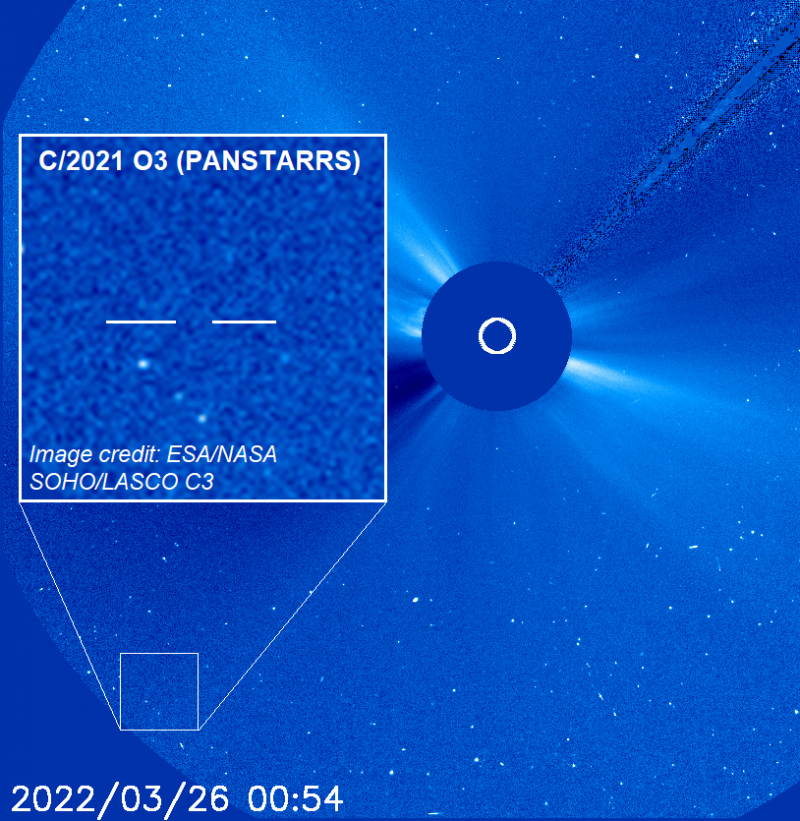
Volition Comet C/2021 O3 be visible to the centre?
Comets are unpredictable, and predicting the brightness of a "new" Oort deject comet is even more hard.
Merely it's likely C/2021 O3 (PanSTARRS) volition not become visible to the heart. At best, it might become a binocular object.
Observing Comet C/2021 O3 (PanSTARRS) might be possible equally early every bit tardily Apr, although and so the comet will be in brighter twilight than in early May. So the view will slightly better past early on May. Even if we are able to run into this comet with binoculars, information technology's possible (maybe likely) that this angelic company will brand simply a brief advent in the skies of amateur observers … mayhap for only a few days. Which days? May iii to vii are a possibility.
Generally, calculations have indicated this comet might reach magnitude +7 or +vi. But other estimates advise Comet C/2021 O3 (PanSTARRS) might appear fifty-fifty fainter, at around magnitude +8 or +9. The comet probably needs to get to around magnitude viii, or brighter, to be visible in virtually binoculars.
So don't too excited if you see some claims that a bright comet is coming. The word bright, in the world of astronomy, is ever relative. And nigh comets do require optical aid to be seen. The graph below shows what we might expect.
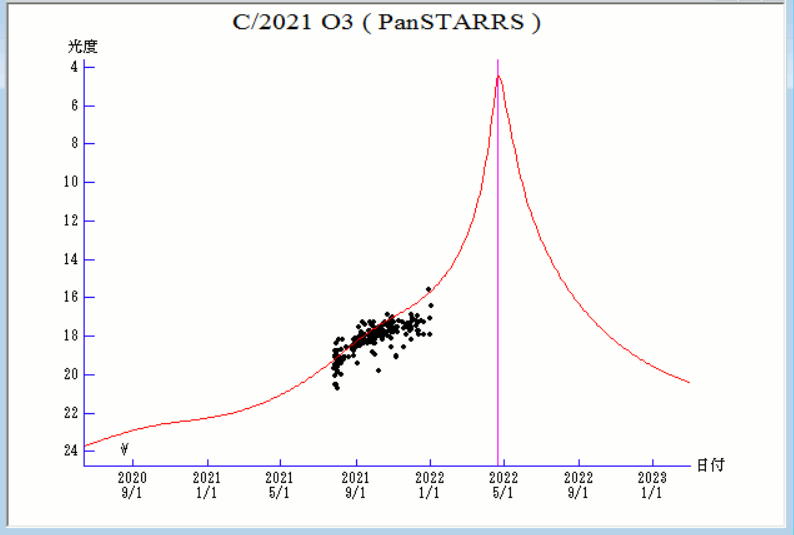
Some other comet
Past the mode, whether Comet C/2021 O3 disappoints or not, there'south another comet discovered by the same observatory in Hawaii that might provide prissy views for observers using modest backyard telescopes during this upcoming northern summer. That other comet is chosen C/2017 K2 (PanSTARRS).
Go along watching the heaven!
Charts for belatedly April and May 2022
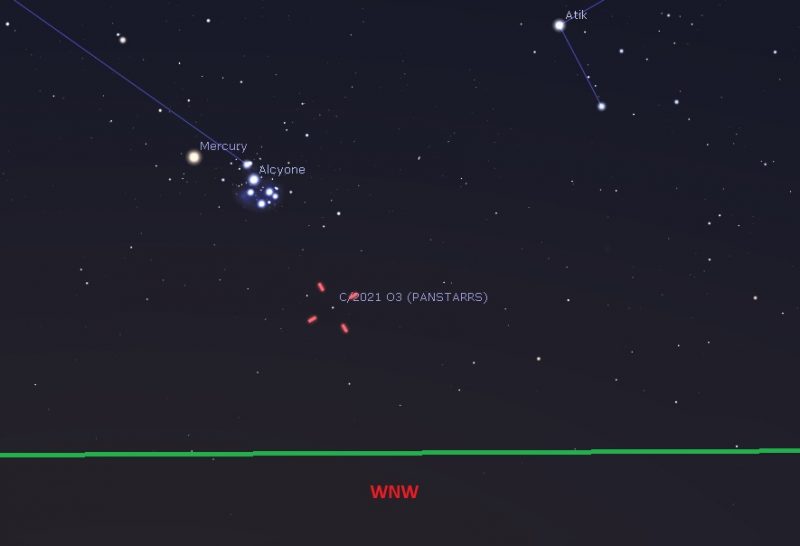
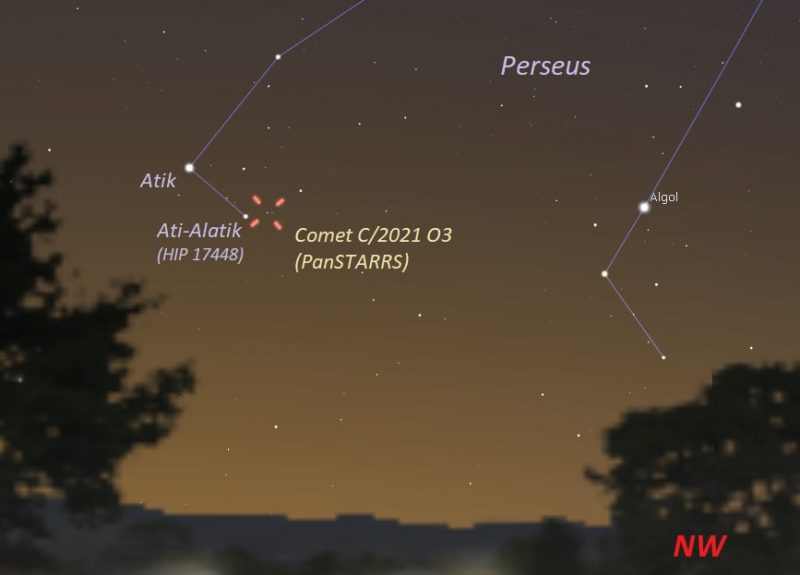
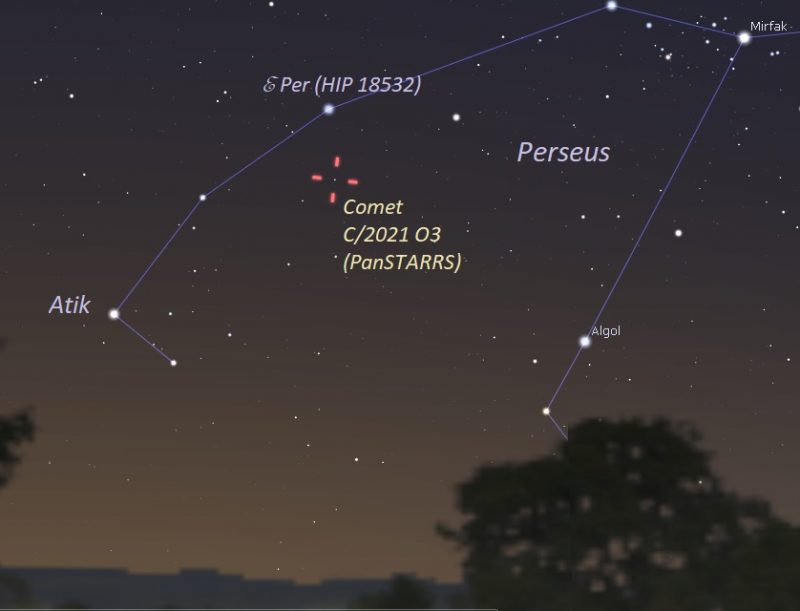
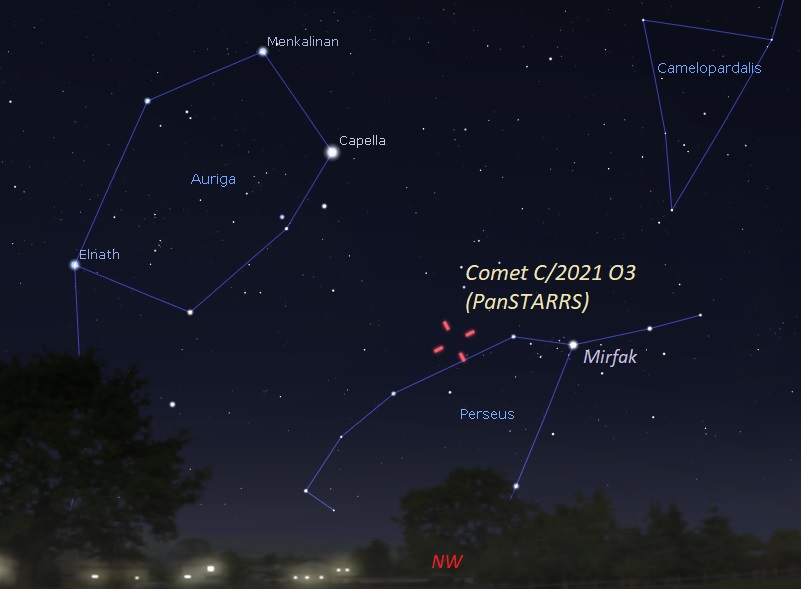
Bottom line: Comet C/2021 O3 (PanSTARRS) is racing towards perihelion in Apr 2022, and then into our evening heaven by early May. Will information technology survive its shut pass near the dominicus? What, if annihilation, volition nosotros encounter during the commencement week of May in our western sky after dusk? Exist amid the first to know. Watch for it in a heaven well-nigh you.
Read: Large comet C/2017 K2 to pass Earth safely in July 2022
Source: https://earthsky.org/astronomy-essentials/comet-c-2021-03-comets-2022/
0 Response to "What is the next comet to be visible from Earth?"
Post a Comment